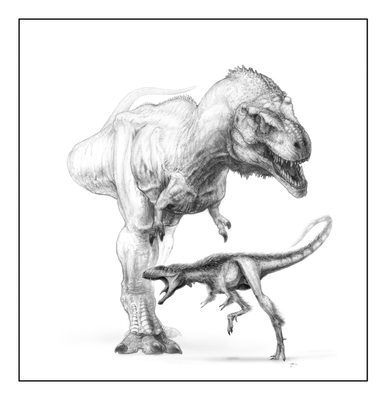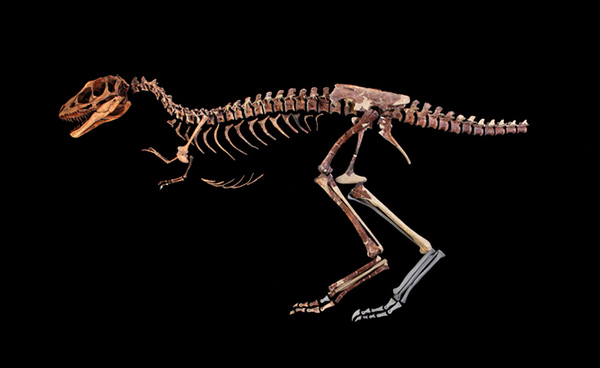
by Carolyn Gramling Thursday, January 5, 2012

_Raptorex _closely resembled its descendent _T. rex_, but weighed as little as one-hundredth as much. Based on a fossil skeleton discovered in Inner Mongolia, China. Illustration: Todd Marshall

Long-legged predator _Raptorex _was entombed in the sediment of an ancient lake margin in northern China 125 million years ago. Photo by Mike Hettwer
The Tyrannosaurus rex — arguably the most famous dinosaur of all time — was also one of the most efficient predators to ever walk on Earth. With its powerful jaws, large eyes, strong hind limbs and even tiny arms, the T. rex was uniquely designed to swiftly run down and dispatch prey. But on Wednesday, scientists announced that those characteristic T. rex features were not as unique as once thought: A new fossil find shows that 60 million years earlier, a T. rex doppelganger — albeit much smaller — was using a very similar set of features to terrorize prey in China.
Raptorex kriegsteini was, in many ways, a T. rex writ small, “a blueprint for what would become in later years,” said paleontologist Paul Sereno of the University of Chicago in Illinois, at a press conference to announce the fossil discovery, which was published in Science today. Although only one-ninetieth the size of T. rex, the two-and-a-half meter tall R. kriegsteini was a miniature version of the roughly 13-meter-tall predators in every mechanically and biologically significant way, he said.
To many dinosaur enthusiasts, T. rex is so familiar that it represents “an icon of prehistory,” but in fact its morphology has been thought to be unique among dinosaurs, said Stephen Brusatte, a doctoral student who was also an author on the paper, at the press conference. T. rex had an enormous head, "longer than an average man is tall, with thick teeth, big olfactory bulbs, strong jaw muscles" and puny arms, Brusatte said. “These features give T. rex a very unusual body plan among dinosaurs.” As a result, he said, many scientists have thought that these signature features evolved as a consequence of the animal’s huge body size.
But the discovery of small-bodied R. kriegsteini changes that perception; instead, the new fossil suggests that these unique features evolved as a result of other factors, perhaps to do with its highly efficient predatory design. For example, Sereno said, the small forelimbs may be related to the animal’s method of attack — running and ripping with its jaws rather than grasping — and thus might have allowed the animal to remain agile, amounting to a set of “jaws on legs,” he said. “It’s the tradeoff you have in life,” he added: “The sickle-shaped claw [of a velociraptor] would be handy, but you can’t run as fast.”
Tyrannosaurs first appeared about 160 million years ago, but no other tyrannosaur fossils exhibit the signature features of the T. rex. “As far as we know, tyrannosaurs only grew to huge sizes during the final 20 million years of the Cretaceous,” when they became the dominant predators in North America and Asia, Brusatte said. For 80 percent of their time on Earth, he said, they were small animals that lived in the shadow of other types of predators. Previously discovered tyrannosaur fossils were more slender and birdlike.
The 125-million-year-old R. kriegsteini fossil has its own interesting history. The fossil was discovered in Early Cretaceous sedimentary rocks in northeastern China — near the lake bed sediments that also produced other famous small predator fossils, including other precursors to the T. rex — sometime in the last century. Then, at some point, the fossil was “spirited away in the dark of night,” Sereno said, and fell into the hands of a private collector. The most recent owner of the fossil, Roman Kriegstein, an eye surgeon and avid paleontology enthusiast, asked Sereno to identify the fossil. In return, Kriegstein agreed to donate it back to science. The fossil will ultimately be returned to China.
As a result of the fossil's unusual history, the scientists were particularly careful to ascertain its origin, to determine that it was neither a juvenile T. rex nor a fraud. “We’re very happy that the specimen is incredibly complete,” Sereno said. The fossil was in a single block, fully articulated and missing only the tip of its tail. Morphological evidence showed that certain bones that fuse when an animal is mature, such as in the sacrum and pelvic area, were mostly fused, suggesting that the animal was nearly full-grown and would reach maybe three meters at full height. By studying a cross-section of a thigh bone under a polarizing light microscope, meanwhile, the scientists determined that it was about 5 to 6 years old — not yet fully mature, but reaching the end of its growth. T. rex, by contrast, matured at about 15 years and was old at 20. The T. rex Sue, housed at Chicago’s Field Museum, was ancient when she died at 28 years old.
The new find suggests that “much of what we thought we knew [about the tyrannosaur group] was simplistic or out-and-out wrong,” Brusatte said. It shows, he added, how “one specimen can completely change our understanding of evolutionary life. It’s as close to the proverbial missing link as we may ever get with tyrannosaurs.”
© 2008-2021. All rights reserved. Any copying, redistribution or retransmission of any of the contents of this service without the expressed written permission of the American Geosciences Institute is expressly prohibited. Click here for all copyright requests.